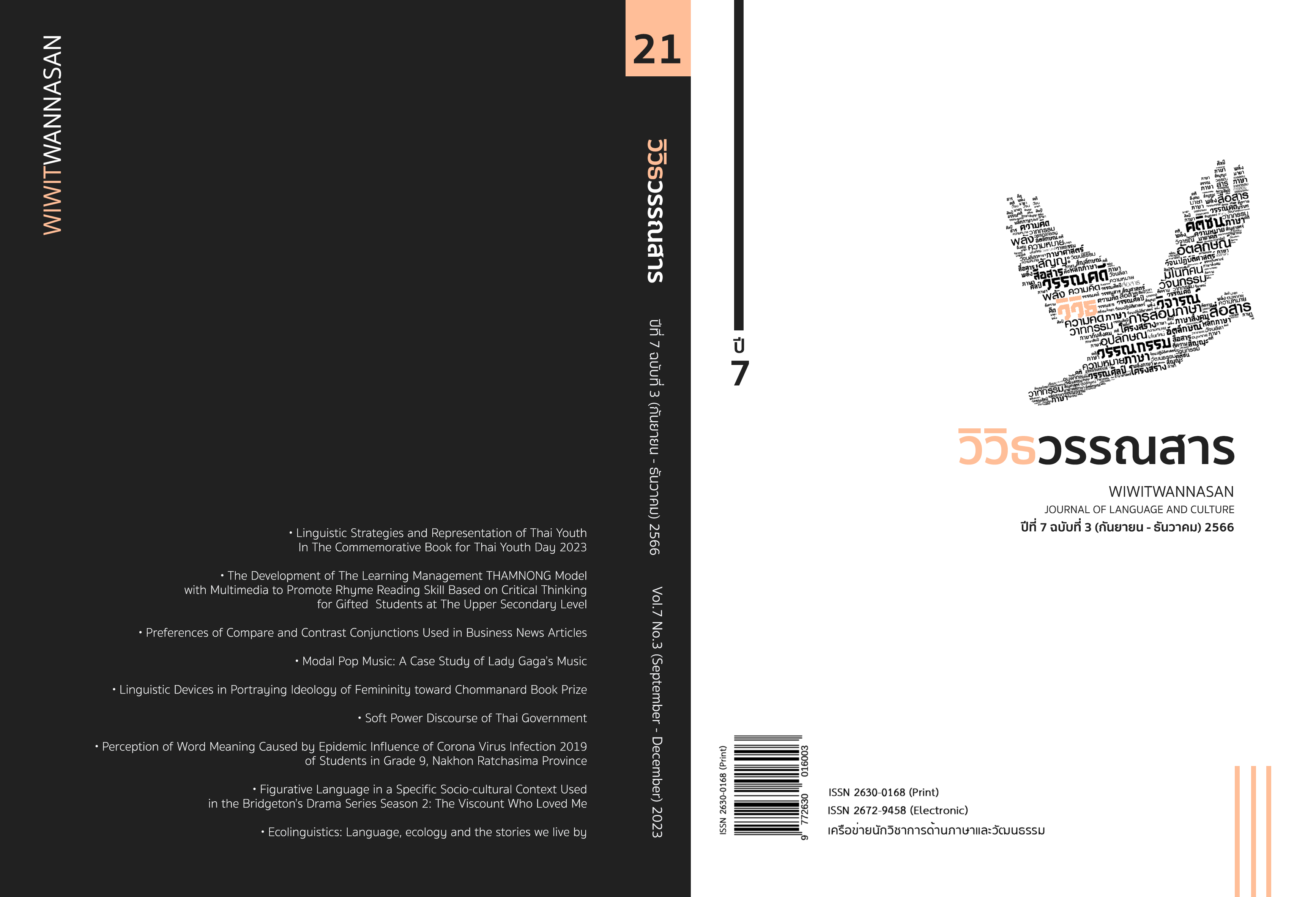กลวิธีทางภาษาในการนำเสนออุดมการณ์ความเป็นหญิงวรรณกรรมรางวัลชมนาด
Main Article Content
บทคัดย่อ
บทความวิจัยนี้มีวัตถุประสงค์เพื่อศึกษากลวิธีทางภาษาในการนำเสนออุดมการณ์ความเป็นหญิงวรรณกรรมรางวัลชมนาด ระหว่างปี พ.ศ.2551 – 2564 ประเภทสารคดี จำนวน 8 เล่ม โดยใช้กรอบแนวคิดกลวิธีทางภาษา การใช้คำ วลี ประโยค และข้อความที่ปรากฏในวรรณกรรมรางวัลชมนาด ผลการวิจัยพบว่า ในการวิเคราะห์ตัวบทจากวรรณกรรมรางวัลชมนาดใช้กลวิธีทางภาษา 8 กลวิธี ได้แก่ กลวิธีการใช้คำ กลวิธีการใช้อุปมา กลวิธีการใช้อุปลักษณ์ กลวิธีการใช้มูลบท กลวิธีการใช้ทัศนภาวะ กลวิธีการกล่าวเกินจริง กลวิธีการใช้คำถามเชิงวาทศิลป์ และกลวิธีการใช้สัญลักษณ์ ที่สะท้อนให้อุดมการณ์ความเป็นหญิงที่แฝงในวรรณกรรมผ่านการใช้ภาษา เพื่อสื่อสารความรู้สึกนึกคิดและอุดมการณ์ความเป็นหญิง การเสนอความจริงในบทบาทหน้าที่ทางสังคมและพื้นที่ในการสร้างการรับรู้ในประเด็นความเป็นหญิง และเพื่อสร้างความยอมรับ ความเท่าเทียมระหว่างชายและหญิง
Article Details

อนุญาตภายใต้เงื่อนไข Creative Commons Attribution-NonCommercial-NoDerivatives 4.0 International License.
ลิขสิทธิ์ของบทความเป็นของวารสาร การพิมพ์ซ้ำจะต้องได้ร้บการอนุญาตจากบรรณาธิการวารสาร
เอกสารอ้างอิง
Angapanichkit, C. (2018). Discourse Analysis (2nd ed.). Bangkok: Chulalongkorn University Press. (In Thai)
Angsuwiriya, C. (2008). Femininity in Sattrisan magazine (1948-1996): A study of relationship between form and meaning (Master’s thesis). Chulalongkorn University Press. (In Thai)
Chaemwong, W. (2015). Linguistic strategies in discourse of advertising of cosmetics in Thai (Research Report). Rajamangala University of Technology Rattanakosin. (In Thai)
Chitchamnong, D. (1984). Thai aesthetics. Bangkok: KhLetthai. (In Thai)
Hongladarom, K. (2000). Discourses on ethnic minorities in Thailand : A study of the Relationship between form and meaning (Research Report). Chulalongkorn University, Bangkok. (In Thai)
Ia-manon, C. (2006). Interaction between language, discourse, and identity of HIV inflected patient: A Nexus analysis. In K. Hongladarom & C. Ia-manon (Eds.), Looking at Thai society through literature. Bangkok: Chulalongkorn University Press. (In Thai)
Kanyarat, K. (2013). Differences between men and women in relationship advisory discourse on salaprachakhom webboard on www.pantip.com: a critical discourse analysis (Master’s thesis). Chulalongkorn University. (In Thai)
Masawisut, N., Sajjaphan, R. & Sukphanit, T. (2010). Man and Woman. In A course syllabus on Thai Thought. Nonthaburi: Sukhothai Thammathirat Open University. (In Thai)
Phakdeephasook, S. (2010). A discourse on femineity in health and beauty magazine in Thai (Research Report). Faculty of Arts, Chulalongkorn University. (In Thai)
Phong Udom, R. (2005). A relationship between language and beauty value: A discourse study of advertising of cosmetics in Thai (Master’s thesis). Chulalongkorn University. (In Thai)
Rakmanee, S. (2008). Language of Literary Arts (3rd ed.). Bangkok: Sai Nam Chai. (In Thai)
Royal Institute. (2011, February 12). Royal Dictionary of Thai Language. Retrieved from https://dict.longdo.com. (In Thai)
RungruengYing, P. (2017). A discourse and identity of lesbians in @Tom actz Magazine (Master’s thesis). Mahasarakham University. (In Thai)
Sawatburi, O. (1990). Counselling column in Thai magazine in reflecting role and status of Thai women (Master’s thesis). Chulalongkorn University. (In Thai)
Worakhot, S. (1999). Feminism in novel of Sriburapha (Master’s thesis). Mahasarakham University. (In Thai)


